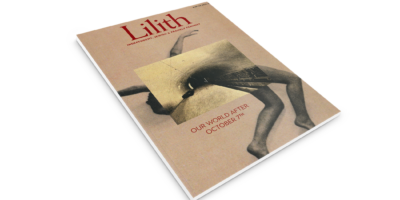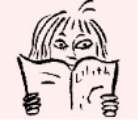A Journalistic Room Of One’s Own
In-depth scholarship on subjects no one has thought to plumb before — like women’s particular Holocaust experiences, or why Jewish families are different, or the reasons why young women seem now so drawn to Yiddish. It was all there from the start. Lilith was the first place to welcome, explicitly, women’s Holocaust memoirs, to uncover the stories of Jewish girls who’d been raised by African-American nannies, and so much more.
Are there differences, in terms of goals, approaches and tone, between the wider women’s movement and the Jewish feminist movement?
We share with the general women’s movement appropriate outrage, and impatience too. But there’s also a certain tenderness that leads us to see more than one correct answer to a problem. I’ve often been asked by interviewers involved in the general women’s movement why Jewish women bother to stay connected to a tradition that was so patriarchal. The question is sometimes phrased as, “Why not just walk away?” Lilith’s mission has been twofold — to push forward the general women’s agenda and to press for full equality in the Jewish world.
In Lilith’s early years we were very diagnostic: “This is what’s wrong with the Jewish world. Here’s how you should fix it.”
By now we see that anger is not usually a useful teaching tool. Feminist outrage is certainly justified in so many of the situations we cover. But as seasoned writers and editors we know that persuasion and passion don’t always need to be seasoned with vinegar … especially when you’re trying to effect change within a community.
Is there a story you feel put you on the map journalistically early on?
I love this question, because it leads me to the framed covers lining the walls of my office, and to the “back issues” section of Lilith’s website. Stories that drew major early attention fall into two categories: those that gave a whole new angle on subjects with a big impact on the Jewish community (like how Jewish women’s feelings about money differ from those of Jewish men and from non-Jewish women) and those stories that revealed things about ourselves that we’d never thought about before. For example, a radical description of what hamantaschen really are (they’re women’s fertility pastries, in case you didn’t know). And there was Lilith’s now-famous “Jewish Hair” issue, which brought me a call from an editor at Glamour sputtering, “Didn’t you know that when you put hair on the cover you sell out all your copies?”
The 1987 story that still makes waves is Lilith’s report of “JAP-Baiting on Campus” — about a rash of virulent verbal attacks on young Jewish women, an ugly amalgam of misogyny and anti-Semitism. The breaking news, plus our analysis of how this (alas, evergreen) stereotype affects young women, made the New York Times, Newsweek, “Oprah” and myriad other news outlets.
Nasty stereotyping of Jewish women just came up again, as a hot topic, in some of the nearly 100 Lilith salons which meet across the country to discuss each new issue of the magazine.
What issues have animated your coverage over the years?
Lilith both illuminates the lives of women in the mainstream of Jewish life and brings to center stage those usually on the margins — Jewish women of color; women with a variety of disabilities (for example, our current cover story—“See Me, Hear Me” — is about the specific concerns of deaf Jewish women); LGBT folks; subsets of women of different enthnicities, like Latina Jews in New York, who aren’t usually thought of when the overall rubric is “Jewish women.”
Lilith has a circulating exhibition with 10 large wall panels (you can see them on our website, Lilith.org), and this “decalogue” spotlights Lilith’s major themes. “Justifying Jewish Law — That Is, Making it More Just”; “Covering the Darker Stories,” about addiction, abuse in Jewish families, family secrets, mental illness; “Our Foremothers” looks at forgotten women, a historical topic we love, because it brings into the light our predecessors in the arts, politics, science. There’s of course a panel for “Big Mouths,” too.
Lilith’s hallmark is really how the magazine amplifies women’s voices. It’s about the telling as much as the tale. Helping an adolescent choose her bat mitzvah dress? Creating rings for your lesbian wedding? Becoming more observant than your parents? Celebrating your Chinese daughter’s bat mitzvah? Worrying about Israel? Figuring out how to conduct your mother’s funeral? Writing a Bill of Rights for your shul? Creating a ritual for your divorce?
One story we’ve been following for decades is called, in our exhibition, “Optioning Motherhood.” Questions about having babies, choosing not to be a mother, ensuring reproductive rights, and more, provide a fascinating timeline, marking changes in Jewish feminists’ concerns. Look at the cover photo on a 1978 issue: a woman’s pregnant torso, with the headline. “Why Jewish Leaders Want Jewish Women To Be Fruitful and Multiply” — all about the outcry from Jewish population studies predicting that Jews would be extinct by the mid-21st century.
Lilith subsequently published articles about infertility, adoption, juggling roles at home and at work, the Jewish stake in abortion rights. And then the powerful hidden stories of unmarried Jewish women who relinquished their babies for adoption in the pre-Roe-v.-Wade era. Then, coverage of classified ads in college newspapers seeking young Jewish women as egg donors, followed by stories of women raising “unconventional” families as single mothers by choice. We shouldn’t be surprised that a complex, inclusive feminist take on the biological and social factors around motherhood provide one of the consistent threads weaving through 35 years.
We’ve heard from Modern Orthodox women who want to edge away from using the word feminism. For them it sounds like fighting old battles. Yet in many ways they stand on the shoulders of the early feminists. How does this phenomenon sit with you?
Ah, fear of feminism.
We stand with the late, great senator and classic Big Mouth, Bella Abzug, who at one point created sticky labels for women to affix to legislation, new curricula, non-sexist ads, etc. The stickers read: “This change is brought to you by feminism.” The fact is that all our lives — stickered or not — have been mightily enriched by feminism, which has opened up the human possibilities for individuals and, pointedly, for all Jews. Like Judaism, feminism teaches us to be alert to individual needs and differences, to offer equal advantage, to level the playing field, to recognize different kinds of bodies and minds. Nothing wrong with that!
Though the women’s movement can claim its share of victories, the issue of equality in the workplace, at least in the Jewish community, seems a tough nut to crack. Why are there so few women federation executives and executives at other Jewish organizations, for example?
Your questions are painful reminders of how much work still has to be done.
Jewish organizations could be a “light unto the nations” by being in the forefront of better labor practices, hiring and promoting women at least equally with men and paying them as well, too. Let’s include in this dream scenario on-premise childcare (since everyone pays lip service to caring about Jewish continuity), job-sharing, a pledge to honor work-life balance and not exploit workers by demanding unreasonable work hours at the sacrifice of personal time.
Also, I’m really sick of hearing that “We just don’t have any women ready in the pipeline.” First, this is willful blindness. Second, there would be even more qualified and experienced women in the Jewish pipeline if there were practices in place to treat them well, mentor them well, pay them well when they are on their way up. Listen to what young women working as professionals in Jewish organizations said about their careers when we invited them to the office for a conversation. Almost none of these smart and capable women saw their work trajectories continuing in the community. Much as they loved what they did, they knew they’d be valued more outside the Jewish world.
There have been stories suggesting men are pulling away from engagement with Reform and Conservative synagogues. Are liberal synagogues becoming a woman’s world? And would you tell men simply to suck it up and find their roles in a changing synagogue environment?
The real answer is considerably more complicated. Women given a chance to learn to read Torah, or take on unfamiliar roles in the services, are eager to learn and lead. But let’s remember that Judaism is a very performance-oriented religion. You have to know how to read in a strange language, get the hang of when to stand and sit, study up on how to lead a seder, and more. The fact that historically so much was denied to women has meant that today a woman can safely say — no shame — “I don’t know how to do it. Teach me.” For men it’s a different story. Remember: it’s like being unwilling to ask directions at a gas station; men often feel humiliated by what they don’t yet know. But as the building popularity of adult bar mitzvah classes (modeled on the hugely popular adult bat mitzvah classes) have shown, men are now starting to come forward. And the new etiquette shows Jewish women opening the doors for Jewish men.



